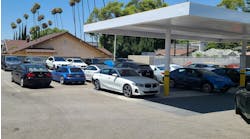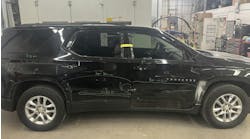Your shop begins repairs on a 2001 Acura CL with moderate front-end damage when you notice that two wires in a harness have been damaged. One is completely severed, while the other has broken and missing insulation. You should do the following:A. Have an experienced, I-CAR-trained tech repair both wires;
B. Have an experienced, I-CAR-trained tech replace both wires;
C. Play it safe and replace the entire harness;
D. Consult the vehicle manufacturer’s repair information, your techs and a mechanical tech, and then proceed with repairs per their recommendations.The correct answer is C—possibly. It’s also possibly A, C or D or even a combination of these options, all depending upon what your shop’s policy is toward wire repairs. When it comes to damaged wiring, the type of repairs that are conducted and where they are conducted is usually a matter of individual shop policy because there’s often no single accepted or correct way to perform this work. The basic goal with wire repair is to create a new connection on a damaged wire that can carry low-level voltages and currents. Around the new connection, add an insulating material that fully seals the connection and protects it from environmental contamination.
In most cases, depending upon manufacturers’ recommendations, you’ll probably be using one of two wire repair methods (see full story). Key elements of each technique are below:
Method 1 tips:
1. Splice the damaged wires. Remove 1 in. of insulation from each wire and spread the strands of wire apart on each exposed portion that will be spliced (See Fig. 1a).
Slip shrink tubing long enough to cover and seal the entire repair area onto one wire. Make sure it’s far enough away to avoid melting during the soldering phase.
Push the two ends of the wires together until the strands of wire are close to the insulation (See Fig. 1b).
Twist the wires together to create an I-CAR-recommended Western Union splice (See Fig. 1c).
2. Center the tubing (slide on wire before twisting ends and soldering) over the joint and use the heat gun to heat the joint until the tubing is tightly sealed. To ensure a proper seal, make sure that sealant comes out of both ends of the tubing (See Fig. 2).
Method 2 tips:
1. Place the strands of wire overlapping each other inside of the splice clip (See Fig. 3) and then use the appropriate size crimping tool to crimp the splice clip and wires together (See Fig. 4). Solder the connection together using rosin core type solder only. Avoid using an acid core solder.
2. Center the tubing over the joint and use the heat gun to heat the joint until the tubing is tightly sealed. Make sure that sealant comes out of both ends of the tubing (See Fig. 2).Fig. 1a-1c
Complicating this situation even more is the fact that wire repairs carry with them significant repercussions. Fail to adequately repair damaged wiring, and your shop could be held liable for such consequences as electrical fires or the failure of supplemental restraint systems. On the other hand, if you turn wire repairs into a long and unnecessarily arduous and expensive process, you risk prolonging cycle times and raising costs, both of which will eventually raise the ire of customers and insurers alike. As a last resort, you could contract out all of your wire repair work and let someone else shoulder the responsibility. But this practice is also costly and can increase cycle time. It’s also shortsighted because it could impair your shop’s ability to conduct business. Consider the following facts: The average new vehicle includes more than three miles of wiring that tie together at least eight computers, 115 small electric motors and dozens of electric components. Add standard features such as sunroofs and electric door locks, and the amount of wiring grows. With the addition of aftermarket products, such as alarm, sound and lighting systems, the amount of wiring grows even more. Add to this the regular introduction of vehicles with innovative bodies designed to house all this wiring and you come to one inevitable conclusion: Body repair and wire repair are permanently intertwined. As wiring becomes more complex, collision repair becomes more challenging, too.To simplify a complicated issue, review your own wire repair practices and revise them as needed. Begin by studying the policies of other shops and the rationale that helped create those policies. Then, spend some time reviewing the current procedures a trained tech uses to complete a top-quality wire repair job. Focus Your Policy
Contemplate the wire repair policies of two very different but successful shops: Len’s Auto Body, an Oceanside, Calif., shop with 38,000 sq. ft. of work space and 30 employees; and Collision Solution Inc., a South Miami, Fla., shop with 8,000 sq. ft. and 11 employees.“The bottom line is that for us this [wire repair] is a liability issue,” says Len Verheyen, owner of Len’s Auto Body. At Verheyen’s shop, an on-site, ASE-certified mechanical technician first runs a diagnostic evaluation on vehicles to determine the existence and extent of any electrical and wire damage. “A lot of times, damage is hidden,” Verheyen says. “You might have two or three visibly damaged wires in a harness, but the majority of damage could be out of view.” After all of the damage is uncovered, Verheyen’s policy is to determine the type of repair based mainly upon the location of the damage.“We automatically replace any wiring that leads back to the engine,” he says. “If the damage leads away from the engine—to the headlamps, for example—then the shop repairs the affected wiring.” As with any rule, there are exceptions. Damaged wires that are part of the air bag system are always replaced. If the wires are in a harness, generally the entire harness is replaced. “To us, this is a safety issue,” Verheyen says. “We’ll always replace wiring instead of repairing it if it could present a danger.”Robert Hughes, owner of Collision Solution Inc., uses a similar policy but executes it differently. Hughes does not keep a mechanical technician on staff, so he contracts out most of his electrical work. “It’s just become too complex,” he says.Difficult or demanding repairs are, therefore, automatically handed off, but Hughes still must decide how they are resolved.
In that respect, his thinking is much like Verheyen’s. For example, Hughes also prefers to install a new harness if any of the wires are damaged, and he is cautious when dealing with any wiring issues. “You have to approach every wire differently,” he says, “Even in a harness every wire can have a different ohm, so if you’re replacing any of them, you have to make sure to use the right type of wire.” Vehicle manufacturers’ recommendations also play a key role in determining these policies because they often describe the procedures that must be used to properly perform a repair and, significantly, keep the vehicle warranty valid. For example, I-CAR notes that a number of manufacturers don’t allow any wires to be repaired, mandating instead that wires or the entire harness be replaced. Many other manufacturers similarly demand the replacement of harness parts if the pig tail is damaged. Recommendations also include requirements for laddering when multiple wires are damaged at the same location on the harness. (Laddering is the amount of stagger needed to prevent contact of adjacent splices.)Another important reason to pay attention to manufacturer recommendations: They can feature essential information on repair kits and materials. Most wire repair kits include such items as splice sleeves, crimp tools, shrink tubes, soldering irons and solder. But some manufacturers provide special kits that include tools and materials made specifically for wire repairs on a particular vehicle make, model or system. If that’s the case, repairers are better off using that kit to provide the best possible job. Finally, these recommendations are invaluable for the time and trouble they can potentially save shops. For example, if a manufacturer dictates that a harness must always be replaced, a shop doesn’t need to waste time trying to fix individual wires or determine just how to handle the repair. It needs only to follow the recommendation. A shop’s first action when dealing with a wiring issue should be to examine the manufacturer’s recommendations. This is how effective policies are built. Developing Policies
With all this in mind, consider how the policies of Len’s Auto Body and Collision Solution might work in a hypothetical situation. Take the quiz scenario at the beginning of this article as an example. Barring an Acura recommendation on how to handle the situation, each shop would act accordingly. Because the wires are in a harness, Verheyen’s shop would most likely have the harness replaced. The same would probably go for Collision Solution Inc., too. Note that in this particular scenario, both policies mandate an action based upon the location of the damage. The only differences are who does the work and where the repair is performed.But both of these repair scenarios could change if the situation were altered, even ever so slightly. For example, if the harness leads away from the engine, Verheyen could ask his technician to run a diagnostic assessment. If the rest of the wires in the harness check out, he could then have the damaged wires repaired or replaced. Similarly, Hughes could have his sublet wire specialist do the same thing. Or, if the harness sits away from the collision impact area and is the only electrical damage, Hughes could ask one of his body techs to repair or replace the damage—depending on how confident both are about the extent of the damage.The bottom line is that both shops use policies that primarily emphasize customer safety and the most thorough repairs. At the same time, each is flexible enough to acknowledge practicality, economics and other valid considerations on a situational basis. The implication is that if shop managers and techs are to successfully abide by these policies, they must both understand wiring repairs and become involved in the work at some level. This requires constant communication and training. “We talk about these things all the time,” Verheyen says. “Our techs are aware of what to look for and what they can do.” Hughes also touches base with his workers and plans to have all of his techs trained by I-CAR to keep up with advancing systems and repair techniques. As technological changes become increasingly complex, both shops will undoubtedly modify their policies as necessary to keep them effective. Wire Repair Basics
Much like shop policies, the procedures used to repair wiring also differ, usually depending upon the extent and location of the damage. The focus here, though, will be on explaining how to perform a wire repair, not a replacement, and a top-quality repair at that—one that should last for the life of the vehicle. With a wire repair, the basic goals are simple: create a new connection on a damaged wire that is more than sufficient to carry low-level voltages and currents. Around the new connection, add an insulating material that fully seals the connection and protects it from environmental contamination. Scott Manna, owner of MB Automotive in Des Plaines, Ill., says the biggest problems he sees are with wiring repairs are those that don’t include a weatherproof insulation. “In the Midwest, road salt will eat through these insulators and damage the connection,” he says. In short, always use an insulator that provides full protection in all climate conditions.
In most cases, depending upon manufacturers’ recommendations, you’ll probably be using one of two wire repair methods.According to DaimlerChrysler Corp., Method 1 relies mainly on soldering and heat shrink tubing, while Method 2 features a splice sleeve or clip and requires less wire for the new connection. Method 1:
1. Begin by splicing the damaged wires. Remove 1 in. of insulation from each wire and spread the strands of wire apart on each exposed portion that will be spliced (See Fig. 1a).
2. Locate a piece of heat shrink tubing long enough to cover and seal the entire repair area. Slip the tubing onto one wire, making sure it’s far enough away to avoid melting during the soldering phase.
3. Push the two ends of the wires together until the strands of wire are close to the insulation (See Fig. 1b).
4. Twist the wires together to create an I-CAR-recommended Western Union splice (See Fig. 1c). This means twisting the wires together in a way that doesn’t leave a tail in the middle that can weaken the joint.
5. Use a rosin core solder (never acid core) to solder the connection. I-CAR warns against using high-wattage solder guns because they can create voltage spikes and generate enough heat to damage electronic components. Instead, use a 15-35 watt, pencil-type soldering iron or a flameless torch (on low heat) with a soldering tip. Make sure the soldering tip is clean and smooth, not corroded, and always tin the tip before using. Do this by applying solder and wiping it off the tip.
5. Center the tubing over the joint and use the heat gun to heat the joint until the tubing is tightly sealed. To ensure a proper seal, make sure that sealant comes out of both ends of the tubing (See Fig. 2).Method 2:
1. Remove 1



